Sometime in August my friend Eric Lewis sends me a message. Eric is a teacher of plant knowledge and permaculture practices in the Maryland area. He’s found a large stand of wild rice in a local river. I’d never harvested wild rice before so the idea of gathering some was exciting, especially rice that was local to the Chesapeake Bay bioregion, only a couple hours drive away from me. I knew that wild rice or Zizania aquatica was a fairly common tidal grass up and down the east coast but I had no experience with it. Wild rice normally conjures up ideas of the north country regions surrounding the Great Lakes, but as I was soon to find out, it is more common and abundant than I had imagined. Eric kept daily watch over the ripening rice, and when it was ready for harvest, I borrowed a canoe and we took to the river…
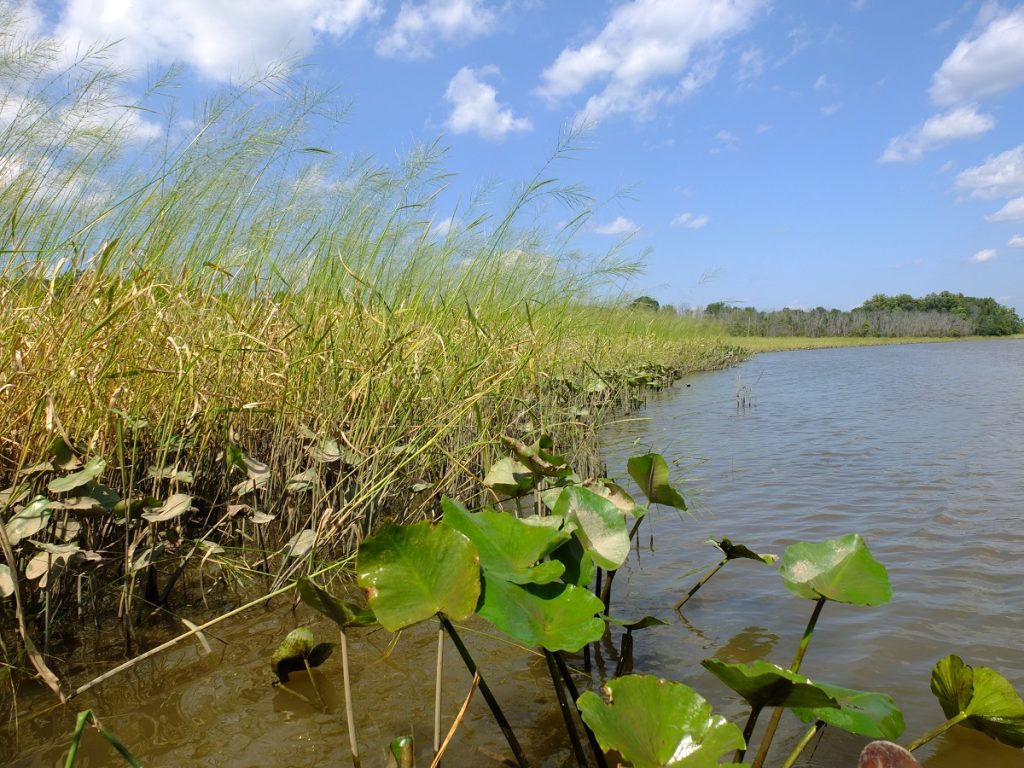
It was the beginning of September, a hot, sunny day on the western shore. In the morning we dropped the canoe into the water at the boat launch and started paddling. Before emptying into the Chesapeake Bay, the river forms a tidal freshwater delta. Here the water is shallow and wide and marshy, from lots of sediment deposition washing down from the uplands. Perfect habitat for wild rice! It was low tide when we put in leaving only the wind for us to battle as we made our way down river with the current.
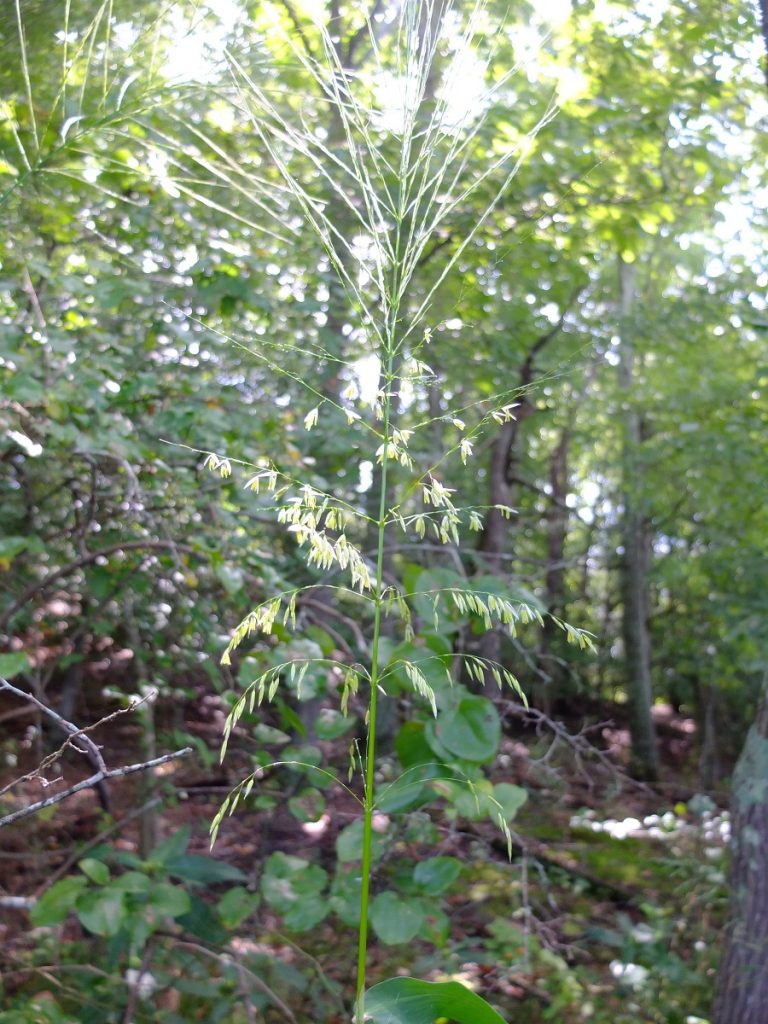
Wild rice is an annual grass in the family Poaceae. It grows well in fresh water like those found in lakes and ponds as well as brackish waters like those found in tidal river deltas and coastal marshes. The Anishinaabe peoples like the Ojibwe of Minnesota (meaning “land of clear blue waters”) call wild rice manoomin (also mahnomen) in their language Anishinaabemowin. It is the keystone to their whole food system. On the east coast, in 1586,Thomas Hariot described the use of wild rice by the Algonquian peoples off the coast of Virginia. “There is a kind of reed which beareth a seed almost like vnto our rie or wheat, & being boiled is good meate.”
Wild rice is hermaphroditic, having both male and female flowers, but it is an outcrossing species and is not self-fertile. The male flowers are found at the top of the plant and release pollen which travels a short distance with the wind. The female flowers are below and resemble dangling tassels which catch the airborne pollen from other plants and develop the rice grains.
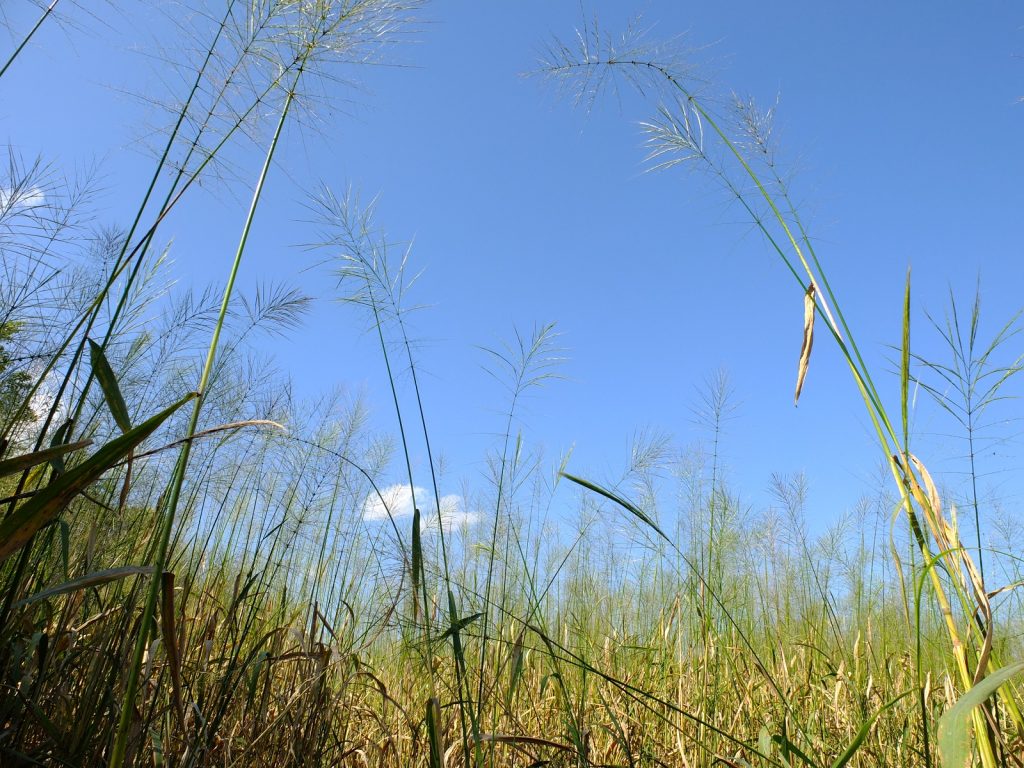
Wild rice germinates in the late winter or the spring. If you’re in the north country, it germinates after the ice begins to break. In the south, it germinates when the water begins to warm. One of the reasons the seed of wild rice is large enough to be food for humans is that it has to store a lot of energy, because the grass has to grow up through a few feet of water before it can reach the sun. Early in the year the wild rice grass is seen growing under the water, standing upright via flotation. By the end of the spring or the beginning of the summer, the grass peeks up above the water where it continues growing to its full stature.
The banks on either side of the river were lined with wild rice for sometimes a solid mile. Growing among the rice were other plants such as wapato (Sagittaria latifolia), tearthumb (Persicaria sagittata), spatterdock (Nyphar advena), and pickerelweed (Pontederia cordata). Suddenly a burst of red would show itself along the shore, the crimson blossoms of red cardinal flower (Lobelia cardinalis).
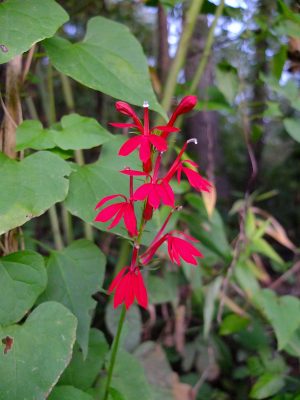
When one gets acquainted with a plant in person, they begin to recognize patterns that are seldom conveyed through the written word of books. Eric and I noticed that the wild rice does not ripen evenly. Some racemes (flowering heads) were still unfolding after beginning in a bundle, but other racemes were fully open and ripe and some already shattering.
Shattering heads of grain are evolutionary adaptations to predation. If a head of grain does not shatter, it holds onto its seed and if an herbivore finds it, it can eat all the grains on the plant easily. By shattering, a plant drops most of its seed quickly at the slightest disturbance, whether that’s a strong gust of wind or the footsteps of an animal brushing by.
Harvesting rice by canoe makes use of the shattering characteristic. When the heads of grain shatter, the falling grains are guided into the broad belly of the boat. This is done traditionally with poles which reach out and bend a bunch of heads of rice over the deck of the boat where they are shaken or knocked off with a stick, dropping the grains into the boat. When the grains drop off they are still covered in papery hulls which must later be removed. As the day progresses, the rice accumulates into a bigger and bigger pile and eventually fills the boat.
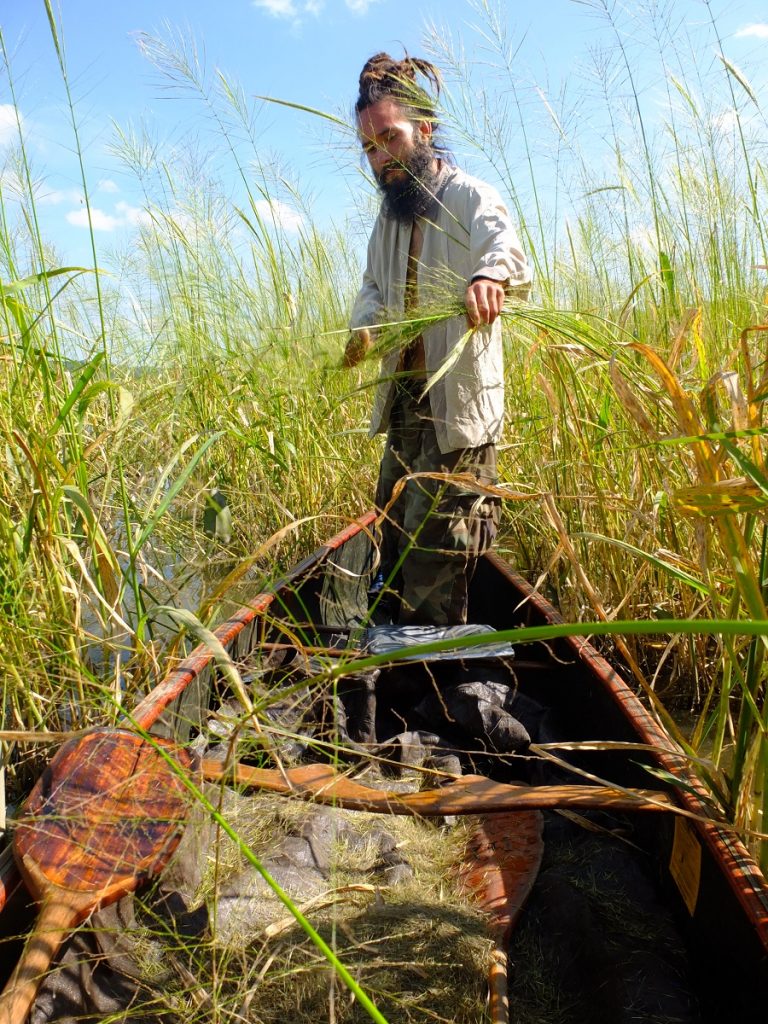
Canada geese and ducks take advantage of the shattering characteristic of wild rice too. The geese will go into the rice patches and bump up against the stalks causing the grains to drop. The grain floats for a brief period of time, on the order of seconds or minutes, but it is enough time for the geese to gobble up all the fallen grains. Geese predation has in the past reduced the wild rice populations on the river we’re paddling. In response, river keepers placed shallow fences around the edges of some of the rice patches to keep the geese out. The patches have since been recovering.
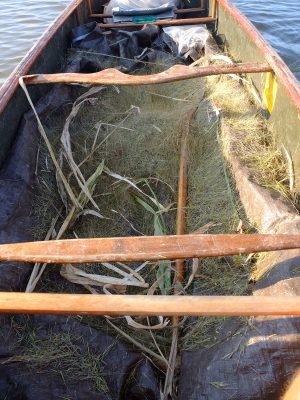
Red-wing blackbirds also greatly enjoy eating the wild rice and flock together in huge groups among the grasses. The blackbirds aren’t large enough to knock the grains off the grasses, but they hang out all day and eat up whatever grains fall naturally.
But there’s another way to increase the abundance of wild rice which doesn’t involve fencing. Human interactions throughout the harvest process ensure that more rice gets planted for the following year than perhaps by any other means. This is because there’s always a portion of rice that doesn’t make it into the boat and goes into the water. How much goes back into the water depends on the experience and technique of the rice harvesters. We had no previous experience ricing and had not yet found efficient ways to harvest on this outing, our first excursion. We spilled at least equal portions of rice overboard as we did over boat. And because our human presence is noisy and alarming to most feathered beings, no rice predators such as Canada geese or red-wing blackbirds were present in our immediate vicinity, allowing that every grain which fell into the water had enough time to sink and settle to the bottom where it is safe from consumption and ready to sprout next year.
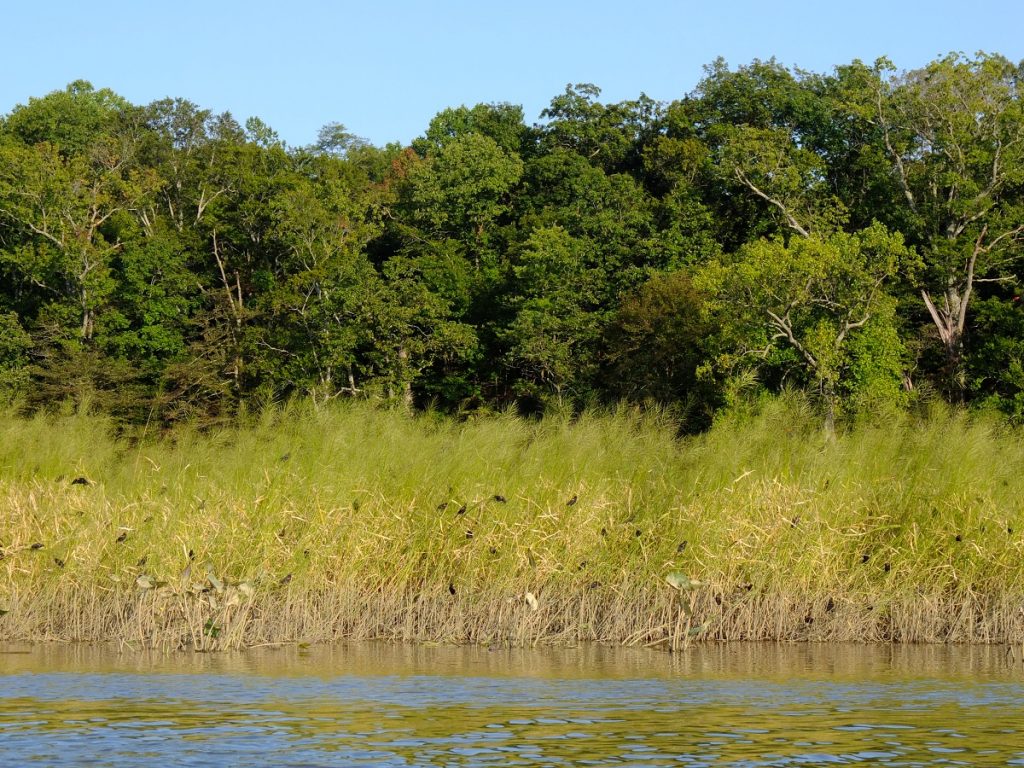
Another boon to the rice populations which occurs in the wake of human harvesting is the riparian disturbance left in the wake. Water-loving plants such as tearthumb, a prickly member of the buckwheat family, have fragile stems which break off wherever a canoe passes over. The bent or broken leftover stalks of the wild rice grasses also serve as something like a mulch or screen shielding the sunlight from neighboring competitor plants such as pickerelweed. As wild rice is harvested in the same location year after year, the ecology begins to change in a way which favors more and more rice. This is demonstrated in the Great Lakes, where native indigenous people have been harvesting rice in particular lakes for centuries. In these lakes the rice grows thick and abundantly, one of nature’s few wild monocultures, as seen in the video below. This doesn’t happen by accident!
Now a note on taxonomy… There seems to be a lack of consensus among botanists as to how the different species of Zizania are related to one another. One school of thought, the “splitters,” break wild rice in the north and south into two separate species, Zizania aquatica along the coast from Florida to Maine (what we harvested), and Zizania palustris which is found in the great lakes regions (shown in the video above). The other group, the “lumpers,” consider both northern and southern wild rice a single species complex Zizania aquatica with several varieties or subspecies.
In addition, there is an endangered wild rice species Zizania texana found along the San Marcos River in Texas, and another species in China, Zizania latifolia.
Whatever the case may be taxonomically, wild rice does have some distinct regional differences, one of the clearest of which is grain size. Northern wild rice tends to have shorter, fatter grains than southern wild rice which tends to have long, thin grains. As a food for humans, northern wild rice thus delivers a better payload than southern wild rice. These differences in grain size are related to climatic differences. Winters are longer in the north, so wild rice needs larger grains to house enough energy to last until spring. The same tendency seems to be true with acorns, where some of our largest acorns such as the bur oak (Quercus macrocarpa) and the red oak (Quercus rubra) are also some of the most cold hardy.
North American wild rice is not to be confused with domesticated Asian rice, which is the genus Oryza. Much of the white or brown rice purchased in markets – often genetically-modified – is Oryza sativa.
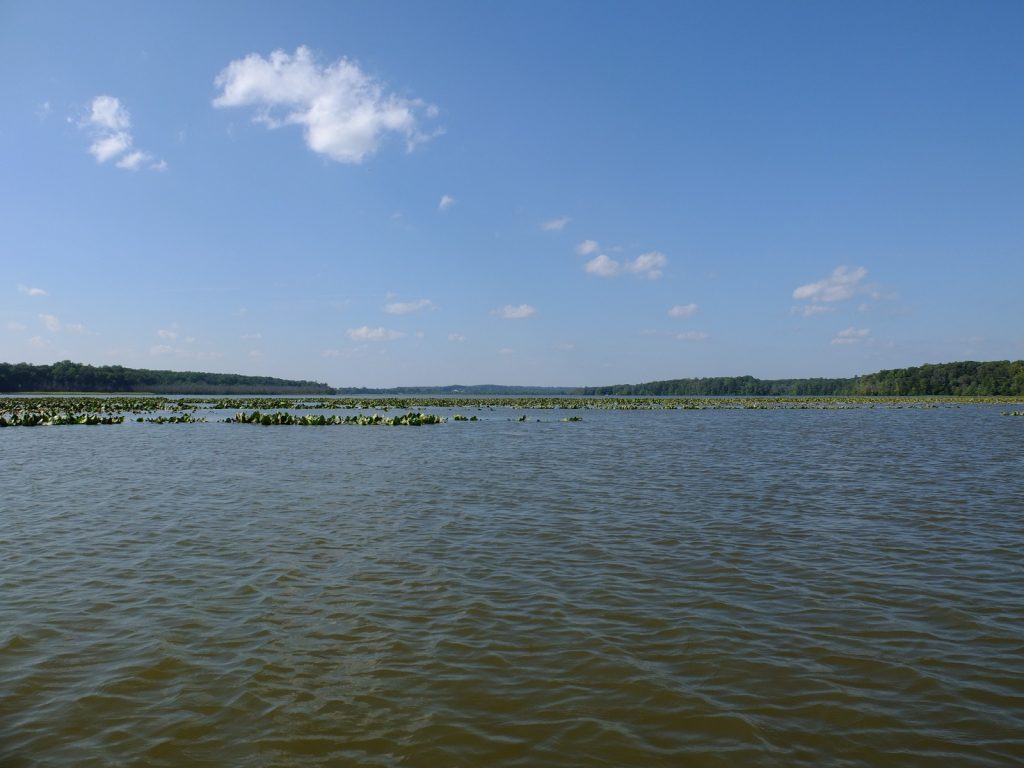
As we got nearer to the Chesapeake, the tug of incoming tide became more dramatic and the river grew wider. As the tides switched, we found ourselves fighting the current. The water level fluctuates a few feet during the day between low tide and high tide. No bother though, because we had already passed by most of the patches anyhow and it was towards the end of the day and the sun was descending in the sky. We were headed towards open waters now. We turned around and went back up the river the way we came in, towards the boat launch. The timing was serendipitous, as the change in the tide allowed us to paddle along with the current just as we had come down, carrying us now through both directions. Departing and returning along with the tide felt like a very natural rhythm.
Being present with the plants led to other observations. We were discussing when to know the proper time to harvest and how long of a window there was before the grains all disappeared under the waters. The date was a Monday, September the 4th, two days prior to the full moon. Our timing seemed slightly on the early side, as if the grain would ripen in the middle of the week, perhaps in accordance with the full moon. The moon holds influence over the tides, and a full moon brings the lowest tides as well as the highest tides. One possible effect among many during the time of full moon is that at low tide more of the wild rice grasses are exposed above the water, causing them to heat up in the late summer sun and quickly ripen their heads of grain. Our observations led us to conclude that the wild rice, at least in this area, ripens around the time of the last full moon before the autumn equinox.
Our first harvest was meager due to our inexperience. We packed a 5 gallon bucket full with unhulled rice grains. After hulling the grains, one can expect to end up with about 1.5-2 gallons of finished rice from those same 5 gallons, which is proportionate with how much finished rice I was able to process out of my half portion from out of the 5 gallons.
We went back on the river a week later, this time bringing along another crew member Katie, Eric’s partner. Just as we had been slightly early the first time we seemed slightly late this time. Sam Thayer, author of books like The Forager’s Harvest and Nature’s Garden, says that there is about a three-day window which is ideal for the harvesting of wild rice, and that seems about right.
Next year we will bring a long pole for pushing the canoe through the denser stands of wild rice. Learning through experience.
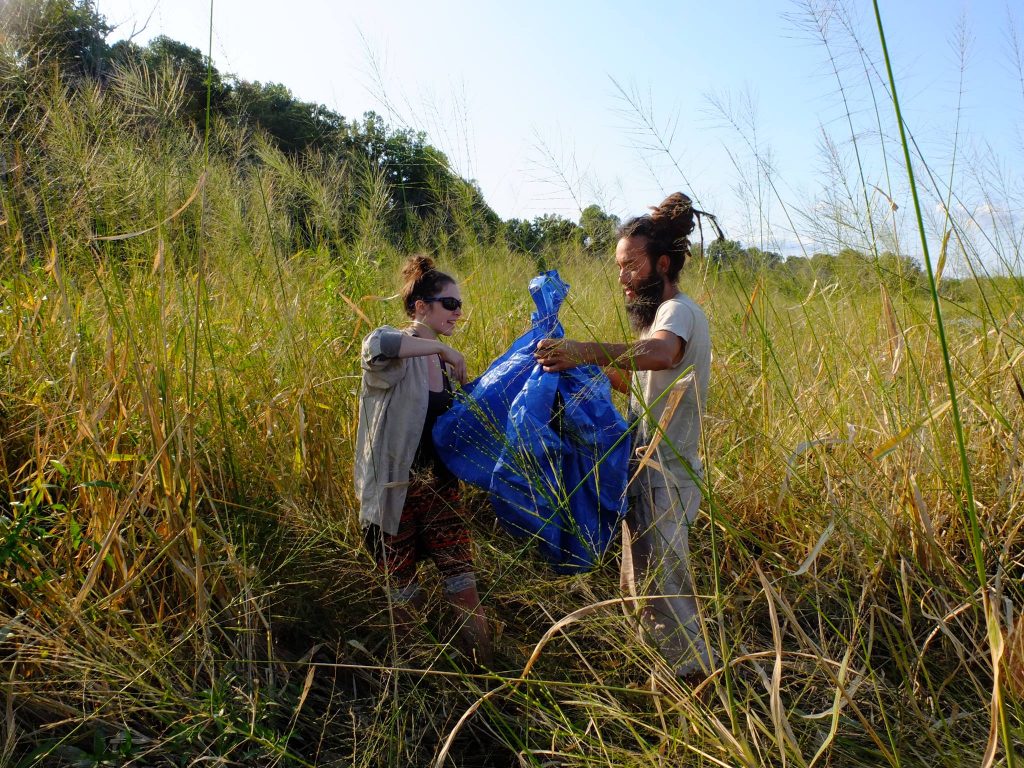
Growing along the shore beside the banks of the river was lots of Apios americana, or groundnut, another important native food plant. I went back to the area a month later for Apios seed of diploid stock. At this time in early October the wild rice grasses lining the shore had turned a rich amber color like fields of wheat. The stalks were dead and drying out in the sun. I thought of how they would be a lively green growing again next year.
Some of the other plants we saw on our wild rice ride included other wild foods like wapato (Sagittaria latifolia), pawpaw (Asimina triloba), and on land, beechnuts (Fagus grandifolia) and mockernuts (Carya tomentosa).
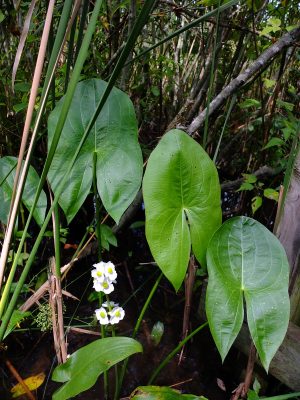
The wapato is a native riparian plant all across North America. In the winter, the starchy tubers may be gathered by mucking about in the shallow waters along the shore, dislodging the tubers which then float to the surface.
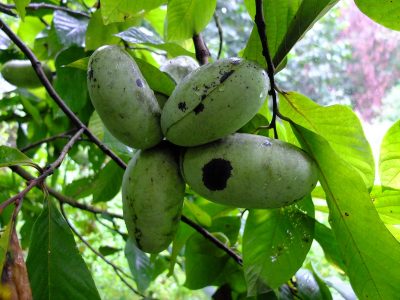
The pawpaw is a passively-domesticated fruit that was brought out of the subtropics and all the way up into some parts of southern Canada by Native Americans centuries ago. It is the largest native fruit in North America and tastes decidedly tropical, with flavors of banana, mango, and coconut inside a custard-y texture which packs a nutritional payload of around 20% fat, like an avocado. The pawpaws were ripe at the same time as our ricing voyage.
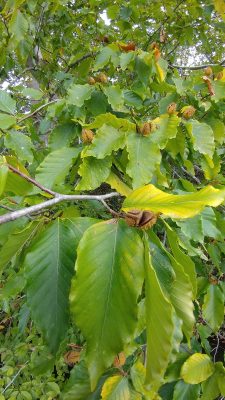
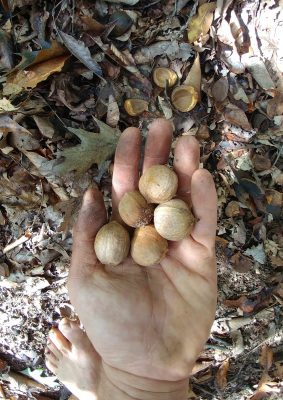
On dry ground beyond the shore, the beechnuts and mockernuts offered up even more nutrition. The beechnuts from the beech tree are in the same family of trees which bring us the chestnut, and the beechnuts tasted not unlike chestnut. Although smaller, the beechnuts lacked tannins and so were not mouth puckering as some raw chestnuts can be. They were sweet and crunchy. Eating raw beechnuts is an experience not unlike eating peanuts… woodland peanuts!
The mockernuts, from the mockernut hickory tree, are rich in fats and have in my opinion the best flavor of all the hickories. The flavor is reminiscent of pecan, which is also a kind of hickory, but these are sweeter and fattier. Mmm! They call it a mockernut though because it is very hard to get the nuts out of the shell. Having the sweetest meat, the nuts mock you with how tough and convoluted their shells are! Once cracked, the meats inside break into pieces and it is difficult to pick them all out even with a nutpick. Why bother then? Well there’s a great work-around to this problem, and the solution is to make a hickory nut milk. Simmer for awhile in water, and the nut meats and fatty acids float to the surface and infuse the liquid with their rich flavor, and the shells sink and remain settled on the bottom, easily strained off. This recipe was called kenuche by the Cherokee and pawcohiccora in an Algonquian tongue (from where we get the word hickory).
I mention these other plants to paint a picture of the abundance of this time of year in this particular place. Wild rice, hickories, pawpaws, groundnuts (Apios americana), wapato, beechnuts, and more… Using vegetables alone this natural system provides for all of our nutritional needs. We can learn much by understanding and experiencing these natural systems, and learning how to work with them through regenerative harvesting practices, that they might increase in abundance year after year. And let’s not forget that the Chesapeake Bay watershed is/was one of the richest in all of North America. Though heavily polluted, damaged, and abused today, the Chesapeake was once a teeming paradise of crabs, Atlantic salmon, eels, shad, alewives, rockfish, striped bass, and oysters. Today the Bay is but a shadow of its former self. In pre-colonial times it was a veritable paradise on Earth.
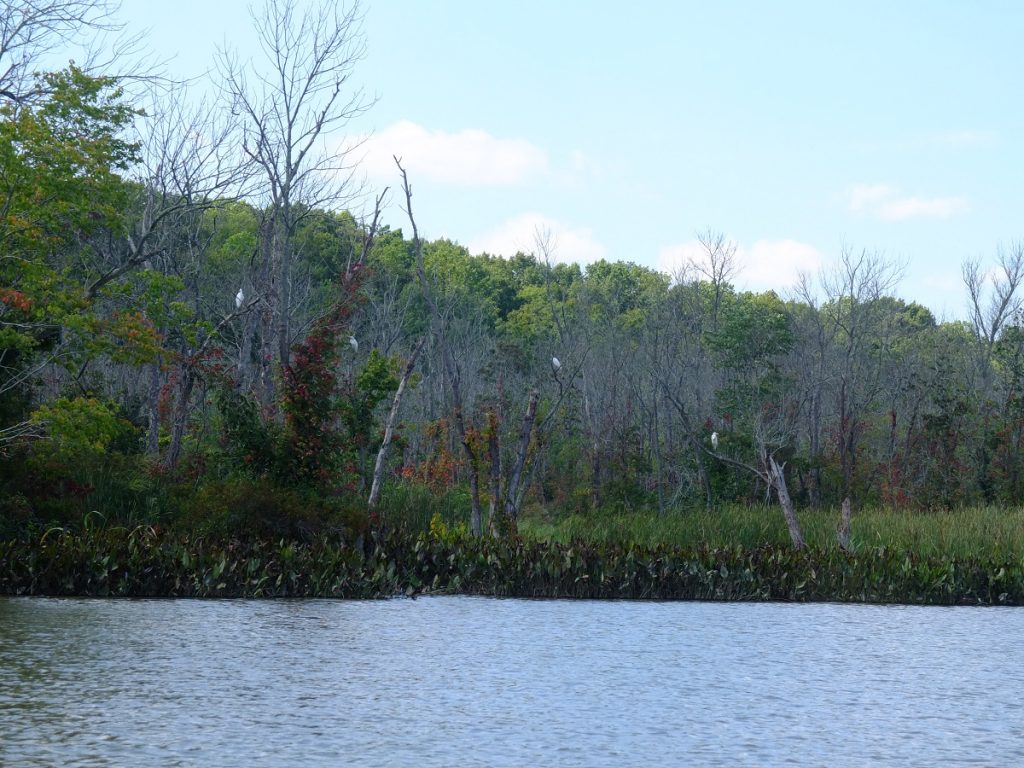
Next, a word on processing. Once the rice has been harvested, there’s more to the story. The rice has to be dried in the sun, parched over fire, threshed, and lastly winnowed. While this may seem like a lot, when you consider how much intensive labor goes into both the growing and processing of corn, the work involved in processing wild rice seems like a pleasant load in comparison.
To dry the rice, it is spread out over a tarp in the sun for a day or two. I covered the tarp lightly, about an inch thick with the rice that was still in the papery hull. After it is dried, it is important to move immediately into the next step of parching. If you wait, the dried rice grains will reabsorb moisture from the air and you will have to start over.
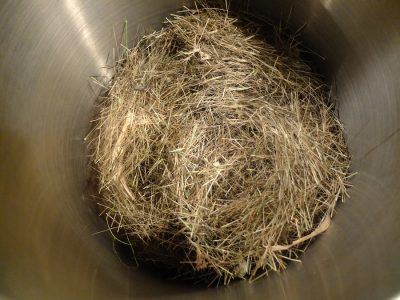
For parching, you pass the unhulled rice through a fire. The fire also imparts a delicious, smoky flavor to the grains which brings a unique and rich character to the rice. The exposure to flame doesn’t need to be done directly but could be done with the rice inside an iron pan, for instance. The important part is that the heat hardens the grains and softens the papery hulls, which allows you to move into the next step of threshing. Not too much heat, though! The grains will pop and puff if in the heat too long. Keep stirring to avoid this. It isn’t the end of the world if it happens, it just means you have puffed rice.
Threshing can be done in a number of ways. If threshing a small amount, it can be done gently with a mortar and pestle, or by beating with your hands. As you beat the grains, each one rubs against the other grains adjacent it, and this tears off the papery hulls. If you’re working with large amounts of wild rice, you can dump it in a bin and jump in, using your feet to thresh the grain. Once the grain and the hulls have separated, you can move on to the last step, winnowing.
Winnowing is done by blowing away the hulls. The grains are heavy and do not blow away. Winnowing can be done effectively by tossing a bowl of grains a short distance into the air so that you can catch them all again back into the bowl. This creates a convection current of air and much of the papery hulls will blow away outside of the bowl with each toss. Do this over and over again until there are no hulls left. Some may inevitably sneak into cooked rice, but they are totally harmless and barely noticeable in small amounts.
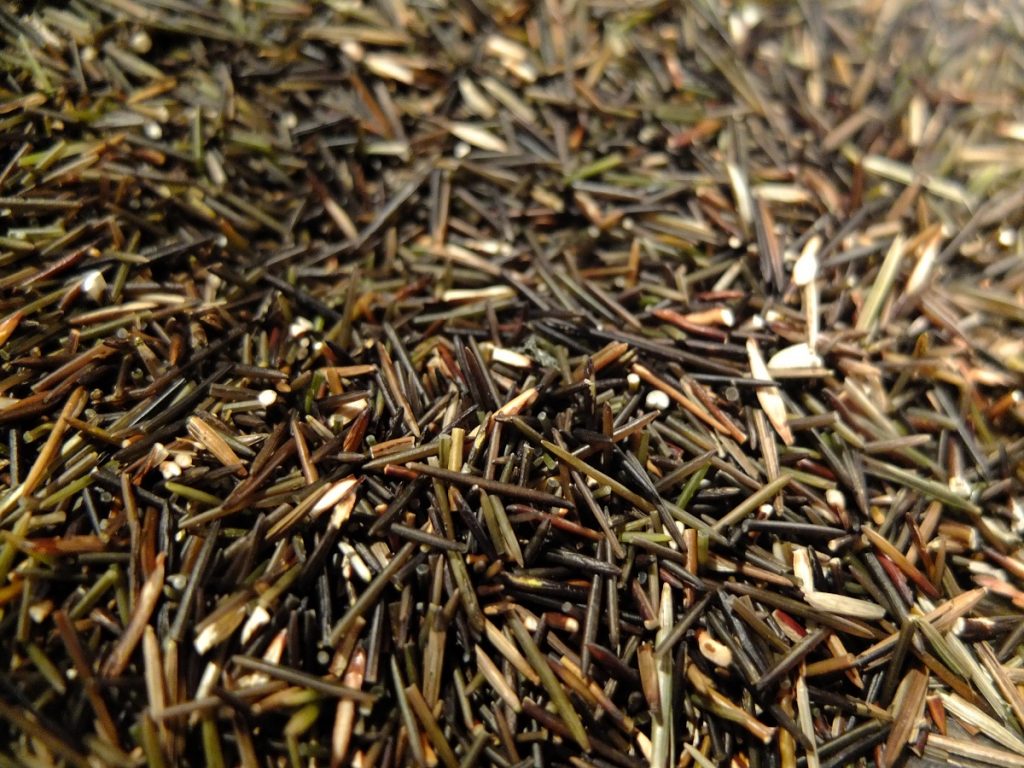
The finished rice will be a range of colors from tan, grey, green, brown, and black. This accounts for the various stages of ripening. Wild rice is packed with flavor and has decent nutritional value. Enjoy!
Finally, a note on planting. Wild rice seed must be kept wet to remain viable. It does not tolerate any drying or it will lose viability. This is an important consideration, because it means if you want to plant wild rice, you ought to get it into water within minutes of knocking it off the plant. For saving fresh grains you might consider carrying a little water in a bucket with you on the canoe during your harvesting.
Wild rice may be planted in fresh or brackish water where the depth is fairly stable between about one foot deep and four feet deep. As an annual grass that is also an outcrosser requiring a population for cross-pollination, it can take a little while to establish rice. Your population will grow slowly if left by itself. If tended intentionally, it will grow a little quicker. But until a certain critical mass is reached, the population won’t be resilient enough to harvest for the purposes of eating. Exercise discernment.